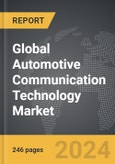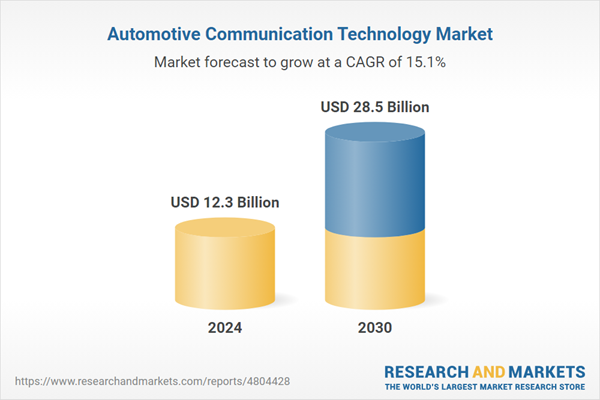The global market for Automotive Communication Technology was valued at US$12.3 Billion in 2024 and is projected to reach US$28.5 Billion by 2030, growing at a CAGR of 15.1% from 2024 to 2030. This comprehensive report provides an in-depth analysis of market trends, drivers, and forecasts, helping you make informed business decisions. The report includes the most recent global tariff developments and how they impact the Automotive Communication Technology market.
Segments: Bus Module (Controller Area Network (CAN), Local Interconnect Network (LIN), Ethernet, Media-Oriented Systems Transport (MOST), FlexRay); Application (Body Control & Comfort, Safety & ADAS, Infotainment & Communication, Powertrain).
Geographic Regions/Countries: World; United States; Canada; Japan; China; Europe (France; Germany; Italy; United Kingdom; and Rest of Europe); Asia-Pacific; Rest of World.
The analysts continuously track trade developments worldwide, drawing insights from leading global economists and over 200 industry and policy institutions, including think tanks, trade organizations, and national economic advisory bodies. This intelligence is integrated into forecasting models to provide timely, data-driven analysis of emerging risks and opportunities.
Global Automotive Communication Technology Market - Key Trends and Drivers Summarized
How Is Automotive Communication Technology Revolutionizing the Driving Experience?
The automotive industry is experiencing a profound transformation, largely driven by advancements in automotive communication technology. But what makes these technologies so pivotal in today’s vehicles? Automotive communication systems enable seamless interaction between various vehicle components, enhancing both safety and convenience. These systems include vehicle-to-vehicle (V2V), vehicle-to-infrastructure (V2I), and in-vehicle communication technologies, which collectively form the backbone of intelligent transportation systems. Through these technologies, vehicles can share real-time data with each other and with surrounding infrastructure, leading to improved traffic management, reduced accident risks, and a more efficient driving experience. The integration of such communication technologies is increasingly becoming standard in modern vehicles, as automakers aim to enhance safety features and provide drivers with advanced capabilities like predictive maintenance, real-time navigation, and smart traffic alerts. This shift is not just about convenience; it’s a critical step towards the future of autonomous driving, where communication between vehicles and their environment will be paramount.What Role Do Emerging Technologies Play in Shaping Automotive Communication?
Emerging technologies are at the core of the ongoing evolution in automotive communication systems. The advent of 5G technology, for instance, is set to revolutionize how vehicles communicate by providing ultra-fast, low-latency connections that are essential for real-time data exchange. This is particularly important for autonomous vehicles, which rely on constant communication with other vehicles, infrastructure, and even pedestrians to make split-second decisions. Furthermore, advancements in artificial intelligence (AI) and machine learning are enabling vehicles to analyze vast amounts of data, predict potential hazards, and optimize communication strategies. The development of Vehicle-to-Everything (V2X) communication, which encompasses V2V, V2I, and Vehicle-to-Pedestrian (V2P) technologies, is further broadening the scope of automotive communication by creating an interconnected ecosystem where all road users can communicate. This technology not only enhances safety and efficiency but also supports the deployment of smart cities, where vehicles, infrastructure, and people are all interconnected through a seamless communication network.How Are Market Dynamics Influencing the Adoption of Automotive Communication Technologies?
The adoption of automotive communication technologies is being driven by a combination of market demands and regulatory pressures. Consumers today are increasingly seeking vehicles that offer advanced connectivity features, such as real-time traffic updates, remote diagnostics, and over-the-air (OTA) updates. This growing consumer expectation is pushing automakers to incorporate sophisticated communication systems into their vehicles. Additionally, the rise of connected and autonomous vehicles is creating a need for robust communication infrastructure that can support these technologies. Governments and regulatory bodies around the world are also playing a significant role by implementing regulations that mandate the inclusion of certain communication technologies in vehicles to improve road safety and reduce traffic congestion. The increasing focus on sustainability is another factor influencing the market, as communication technologies can help optimize vehicle efficiency and reduce emissions by enabling better traffic management and reducing idle times.What Are the Key Growth Drivers in the Automotive Communication Technology Market?
The growth in the automotive communication technology market is driven by several factors that are reshaping the automotive landscape. A key driver is the rapid development and deployment of 5G networks, which are essential for the widespread adoption of advanced communication systems in vehicles. The increasing penetration of connected vehicles is another major factor, as more automakers integrate communication technologies to meet consumer demand for seamless connectivity and enhanced driving experiences. The push towards autonomous vehicles is also driving demand for sophisticated communication systems that can support real-time data exchange and decision-making processes. Moreover, the expansion of smart cities and the need for integrated transportation solutions are creating new opportunities for the adoption of Vehicle-to-Everything (V2X) technologies. Regulatory mandates, particularly those focused on improving road safety and reducing emissions, are further accelerating the adoption of these technologies. Lastly, consumer preferences are shifting towards vehicles that offer advanced safety and convenience features, which is driving automakers to invest in and deploy cutting-edge communication technologies across their vehicle lineups.Report Scope
The report analyzes the Automotive Communication Technology market, presented in terms of units. The analysis covers the key segments and geographic regions outlined below.Segments: Bus Module (Controller Area Network (CAN), Local Interconnect Network (LIN), Ethernet, Media-Oriented Systems Transport (MOST), FlexRay); Application (Body Control & Comfort, Safety & ADAS, Infotainment & Communication, Powertrain).
Geographic Regions/Countries: World; United States; Canada; Japan; China; Europe (France; Germany; Italy; United Kingdom; and Rest of Europe); Asia-Pacific; Rest of World.
Key Insights:
- Market Growth: Understand the significant growth trajectory of the Controller Area Network (CAN) Bus Module segment, which is expected to reach US$11.4 Billion by 2030 with a CAGR of a 14.6%. The Local Interconnect Network (LIN) Bus Module segment is also set to grow at 14.9% CAGR over the analysis period.
- Regional Analysis: Gain insights into the U.S. market, valued at $3.3 Billion in 2024, and China, forecasted to grow at an impressive 13.9% CAGR to reach $4.3 Billion by 2030. Discover growth trends in other key regions, including Japan, Canada, Germany, and the Asia-Pacific.
Why You Should Buy This Report:
- Detailed Market Analysis: Access a thorough analysis of the Global Automotive Communication Technology Market, covering all major geographic regions and market segments.
- Competitive Insights: Get an overview of the competitive landscape, including the market presence of major players across different geographies.
- Future Trends and Drivers: Understand the key trends and drivers shaping the future of the Global Automotive Communication Technology Market.
- Actionable Insights: Benefit from actionable insights that can help you identify new revenue opportunities and make strategic business decisions.
Key Questions Answered:
- How is the Global Automotive Communication Technology Market expected to evolve by 2030?
- What are the main drivers and restraints affecting the market?
- Which market segments will grow the most over the forecast period?
- How will market shares for different regions and segments change by 2030?
- Who are the leading players in the market, and what are their prospects?
Report Features:
- Comprehensive Market Data: Independent analysis of annual sales and market forecasts in US$ Million from 2024 to 2030.
- In-Depth Regional Analysis: Detailed insights into key markets, including the U.S., China, Japan, Canada, Europe, Asia-Pacific, Latin America, Middle East, and Africa.
- Company Profiles: Coverage of players such as Broadcom Ltd., Continental AG, Cypress Semiconductor Corporation, Elmos Semiconductor AG, Infineon Technologies AG and more.
- Complimentary Updates: Receive free report updates for one year to keep you informed of the latest market developments.
Some of the 46 companies featured in this Automotive Communication Technology market report include:
- Broadcom Ltd.
- Continental AG
- Cypress Semiconductor Corporation
- Elmos Semiconductor AG
- Infineon Technologies AG
- Intel Corporation
- Maxim Integrated Products, Inc.
- Melexis NV
- Microchip Technology, Inc.
- NXP Semiconductors NV
- ON Semiconductor Corporation
- Qualcomm, Inc.
- Renesas Electronics Corporation
- Robert Bosch GmbH
- Rohm Semiconductors
- STMicroelectronics
- Texas Instruments, Inc.
- Toshiba Corporation
- Vector Informatik GmbH
- Xilinx Inc.
Tariff Impact Analysis: Key Insights for 2025
Global tariff negotiations across 180+ countries are reshaping supply chains, costs, and competitiveness. This report reflects the latest developments as of April 2025 and incorporates forward-looking insights into the market outlook.The analysts continuously track trade developments worldwide, drawing insights from leading global economists and over 200 industry and policy institutions, including think tanks, trade organizations, and national economic advisory bodies. This intelligence is integrated into forecasting models to provide timely, data-driven analysis of emerging risks and opportunities.
What’s Included in This Edition:
- Tariff-adjusted market forecasts by region and segment
- Analysis of cost and supply chain implications by sourcing and trade exposure
- Strategic insights into geographic shifts
Buyers receive a free July 2025 update with:
- Finalized tariff impacts and new trade agreement effects
- Updated projections reflecting global sourcing and cost shifts
- Expanded country-specific coverage across the industry
Table of Contents
I. METHODOLOGYII. EXECUTIVE SUMMARY2. FOCUS ON SELECT PLAYERSIII. MARKET ANALYSISIV. COMPETITION
1. MARKET OVERVIEW
3. MARKET TRENDS & DRIVERS
4. GLOBAL MARKET PERSPECTIVE
UNITED STATES
CANADA
JAPAN
CHINA
EUROPE
FRANCE
GERMANY
ITALY
UNITED KINGDOM
REST OF EUROPE
ASIA-PACIFIC
REST OF WORLD
Companies Mentioned (Partial List)
A selection of companies mentioned in this report includes, but is not limited to:
- Broadcom Ltd.
- Continental AG
- Cypress Semiconductor Corporation
- Elmos Semiconductor AG
- Infineon Technologies AG
- Intel Corporation
- Maxim Integrated Products, Inc.
- Melexis NV
- Microchip Technology, Inc.
- NXP Semiconductors NV
- ON Semiconductor Corporation
- Qualcomm, Inc.
- Renesas Electronics Corporation
- Robert Bosch GmbH
- Rohm Semiconductors
- STMicroelectronics
- Texas Instruments, Inc.
- Toshiba Corporation
- Vector Informatik GmbH
- Xilinx Inc.
Table Information
| Report Attribute | Details |
|---|---|
| No. of Pages | 246 |
| Published | April 2025 |
| Forecast Period | 2024 - 2030 |
| Estimated Market Value ( USD | $ 12.3 Billion |
| Forecasted Market Value ( USD | $ 28.5 Billion |
| Compound Annual Growth Rate | 15.1% |
| Regions Covered | Global |









